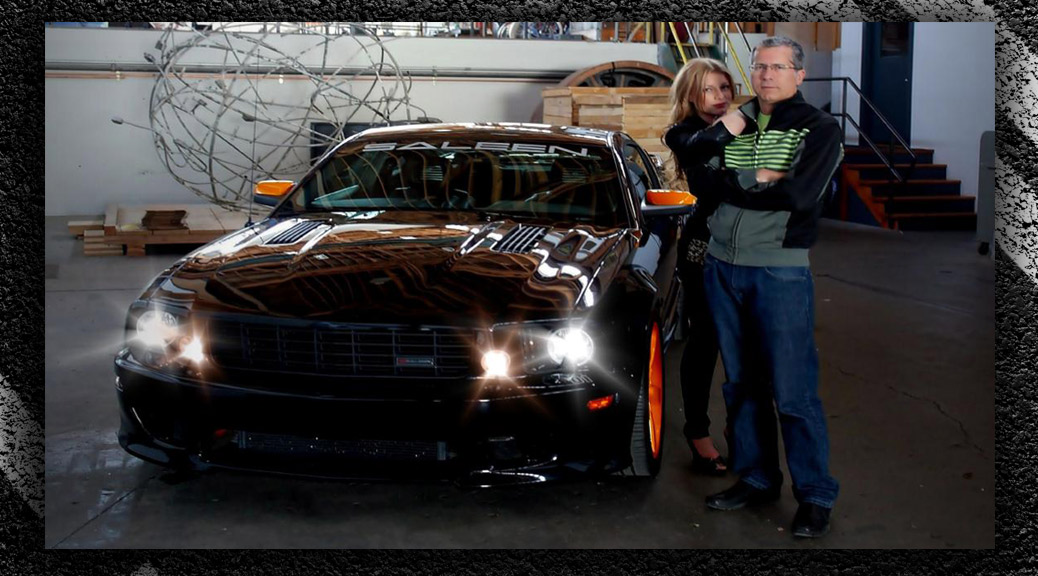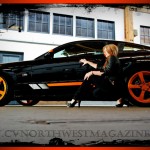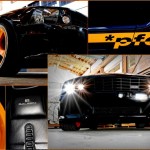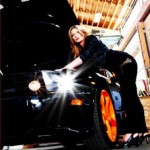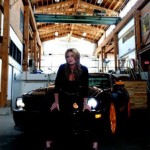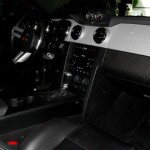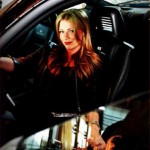By: STAN PERRET
Original Article: CV Northwest
Issue: June, 2012
In-depth Interview with the designer of the Saleen Mustang, Mr. Phil Frank:
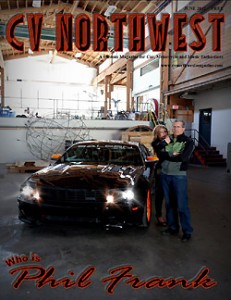
What is your design background?
My degree and profession is called Industrial Design, which basically addresses every consumer, medical or transportation product that we interact with in our daily lives, from phones, computers, watches, ovens, chairs, cars, power tools, etc. you name it and there is an Industrial Designer behind it at some point.
I see you worked at Nike, how did that prepare you for your future?
Nike was a great learning experience from a design, marketing and branding standpoint. They focus on great product with the end consumer in mind. I was in the Equipment group which was a new business and as such was somewhat independent of the big mother ship, se we were able to experiment in many different categories. I worked on sport, training and lifestyle equipment, watches, bags and eyewear, with eyewear being the most sensitive consumer product any designer can work on, as you are asking someone to wear something you design on their face, which is a bit different from a mobile phone or refrigerator.
How did you get into automobile design?
Well my dad was a car guy and an artist / cartoonist and so O inherited his automotive passion and artist capabilities. He was always restoring Ford Model A’s, MG TC’s or weird old Jaguars which were a bit too old and slow for my tastes so I leaned toward the future of what was next.
During high school I took some drafting classes but found the T-square, straight edge and #4H pencils were not the creative challenge I was after. For one birthday my dad got me a book about Raymond Lowey, the designer famous for beginning to define what an Industrial Designer should be. Lowey had also designed the Studebaker Lark and Avanti, which further peaked my interest into the field, so I began to look into getting a proper design education. I looked at Art Center down in Pasadena, California which was the main school for car design at the time, but the tuition was more than we were able to afford, so it was a State school for me. San Jose State University has an Industrial Design program, so I applied and got in.
The first two years were spent learning the design fundamentals pf perspective, sketching, problem solving, etc. Product Design at the time was pretty boring boxy stuff, so I took the Transportation Design elective with instructor Del Coats, who had worked at Ford back in the 1960’s. For the next two years I took the course over and over with a group of five or six buddies, but I’m the only Transpo guy who ended up following through on part of the car dream, though they have all done extremely well in the Product Design field.
How did you decide to get into working with Steve Saleen?
Well, what I’ve found over my years is that everything and everyone is connected to your path in life. While I was at SJSU I was granted an internship for the spring semester in the Ford Advanced Design Studio. While I was in Michigan, Ford sponsored a design program with the SJSU Transportation Design class. The project was for each student to design and hand model a one-fifth scale semi-tractor and trailer rig, which ends up being about 8’ long! To accomplish this Ford sent an actual trailer full of 8” x 16” x 8’ bricks of beautiful urethane foam, which is every starving design student’s dream when a two foot section could pay for a month’s worth of food! Along the way the class decided they would rather do more manageable one-tenth scale models, so what I got back to San Jose in June I found a huge mountain of pristine foam blocks looking to be exploited.
So, the following semester I decided I was going to do a full-size model for my senior project, which is a Shakespeare like story to fill another article someday. Anyway, the model didn’t land me a car design position as I happened to graduate during a down swing in the industry, but it did get a bit of magazine press. From that I ended up being invited to bring it to the SEMA show in Las Vegas for a design display, and this is where I met Steve on the last hour of the last day, which basically led to our collaboration over the last 20 years.
After the demise of Saleen, did you have any concerns about joining SMS Supercars?
Not as much as I should have, my wife took care of that. In 2005 I took a six month leave of absence from Nike to begin the design of the Saleen S5, that was to be based upon the GT chassis (neither Steve or I were involved in the ASC/Saleen S5 Raptor concept from 2008), unfortunately this project never started for whatever business reason, so in place of the S5 pro-gram I ended up designing and managed the construction of The Saleen Store in Irvine, California, which was a huge success for Saleen, Inc. Almost the day after its completion my leave was over so I went back to Nike, for one day, which was a bit like going back to live with your parents after ten years on your own, I made the call to Saleen that I was ready to work full time for them.
A day later I resigned from Nike and Saleen, Inc. hired me as the VP of Design. The honeymoon lasted all of six months be-fore the Great Recession rained down upon us and I got laid off with a bunch of other people. At this point the writing was on the wall for Saleen, Inc. as the VC owners/investors were pouring gasoline on the fire. After my lay-off Steve and I began our behind the scenes collaboration on creating our new company, about three months later he resigned and we moved to officially start the new endeavor as SMS Supercars.
SMS Supercars was built from my visionary direction for Saleen, Inc., that the business needed to address the resurgent American Muscle Car opportunities with ultra-high performance derivatives of the Challenger, Camaro and Mustang. This plan would help ease the up and down single model cycle that was always a challenge.
The trouble with SMS Supercars, which has now been rebranded as Saleen as Steve has supposedly gained the naming rights back, is that his business model has not evolved from the Fox Body days which is unfortunate. It was easy to throw on some springs, shocks, brakes, body work and stickers on a Fox, SN-95 or S-197 and make it handle and look much better than the stock version, but today’s reality is that the OEM’s are not leaving the performance segment to the aftermarket, you can buy a GT500 Mustang with 622 HP that does 202 MPH for under $60k with full dealer support and warrantee! How can a niche manufacturer compete with that with zero engineering, development or marketing resources? There is an old saying that I think is unfortunately fitting to the current situation with the company, “those who don’t like change are really going to hate irrelevance.” That is just my point of view.”
When you design automobiles, what is your philosophy and focus?
Well performance cars are the ultimate extensions of our extroverted personalities and as such any time I’m working on a design for one of these I focus on creating the right attitude. My “Illicit” full size show car from SJSU was inspired by the predatory attitude of a shark, this show car influenced the entire design language of all the Saleen vehicles I’ve been involved in. Basically it you are cruising in the fast lane and you see one of my cars closing on you in your rear view mirror your basic fight or flight instinct kicks in and you get the hell out of its way as “that thing is going t kill me” flashes in your mind! I guess that would answer it.
Do you prefer performance over aesthetics, or vis-versa?
I like to create what I call objects of desire, and it they happen to go fast even better. I’ve always been a spirited driver, but the performance threshold of today’s cars is so high it’s hard to take advantage of them safely or legally on the streets. To give me the dose of speed filled adrenaline I require I started a 24 Hours of LeMons and Chump Car team three years ago and I am having a blast! All I can say is EVERYONE reading this needs to do this. It is real racing on a viable budget. As Jay Lamm creator of LeMons says “Racing is not just for rich idiots anymore, it’s for all idiots.” Where else can you race with over 100 cars on some of the best tracks in the USA? That and it’s a lot less expensive to put your $500.00 race car into the tire wall at turn nine than your daily driver.
What do you use as your inner inspiration for your design work?
I look outside the category that I’m designing for, so if I’m designing a car I don’t look at other cars, for the Saleen S7 I looked to aerodynamic objects such as turbines, wind tunnels and also a bit of the predatory shark genre. The same can be said for the products I design, though these are typically problem solving exercises first and then aesthetic come into play, typically I draw from my diverse experiences to bring something new to the table and I generally try to avoid looking at the other have done with comparable products.
What are you most proud of, what do you feel is you biggest accomplishment?
That is a tough one, the Saleen S7 is definitely a major achievement for an independent designer, though I would have liked to have been able to have more time to refine both the exterior and interior, but we were just working so fast. The 1994 Saleen Mustang was great as I took the design from sketch to hand model and it was my first paying automotive consulting gig. The 2005 S281 was great as it was the first fully 3D CAD driven aftermarket design where I was able to do everything I wanted at the level of refinement that I am accustomed to, the PJ and S331 that followed from there were to the same level.
The Saleen Store was an entirely new genre for me to work in so that was an important learning experience, it was also very successful for the business as it introduced the brand to a more mainstream consumer, but at a very high level. The building of the entire SMS brand, facility, vehicles, supercharger, products, marketing, etc., was a huge accomplishment, made even more challenging with little to no budget other than my sweat equity, which unfortunately is still a point of contention.
I enjoyed all of the design opportunities at Nike, as the products I did there embody the same lifestyle passion I have for car design, just in watches, eyewear or high-end bags. I even designed the Nike ONE 2022, a purely digital concept car for the Nike/Sony Gran Turismo 4 Collaboration. Defining what a Nike car could, should and would be was a completely groundbreaking project, and in the end it will stand the test of time doe innovation and aesthetics.
So to answer your question I would have to say I’m most proud of all the opportunities I’ve been involved in, as each one has taught me something for the next one.
Click on this link to visit cvworldwidemagazine.com and download the Magazine

